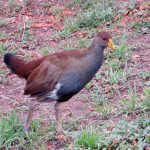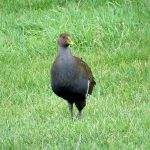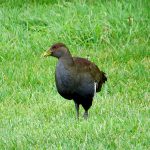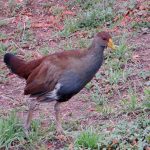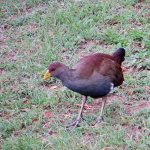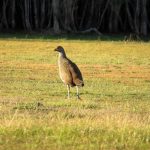TASMANIAN NATIVEHEN
(Tribonyx mortierii)
The Tasmanian nativehen is a fascinating and unique bird species that calls Tasmania its home. As its name suggests, it is endemic to this region, meaning it’s not naturally found anywhere else in the world.
Picture, if you will, the rolling landscapes of Tasmania, with its lush, verdant pastures and the dense, temperate rainforests that intermingle with the serene waterways. It is here, amidst this tranquil backdrop, that the Tasmanian nativehen thrives.
The nativehen bears a resemblance to a small, robust, flightless hen, with a predominantly grey-brown plumage that allows it to blend seamlessly with its surroundings. Its strong legs are a distinctive feature, hinting at its remarkable ability to run swiftly, which compensates for its lack of flight. Indeed, these birds can sprint at impressive speeds of up to 50 kilometres per hour when they feel the need to escape from potential threats.
Tasmanian nativehens are usually found in the more temperate parts of Tasmania, often in close proximity to bodies of freshwater like rivers, lakes, and marshes. They have a particular fondness for grasslands and open spaces where they can forage for their diet of seeds, plants, and small invertebrates.
One of the most intriguing aspects of the nativehen is its social behaviour. They live in groups, or ‘tribes’, which can number from a handful of birds to over a hundred. These tribes establish territories, which they defend vociferously against other nativehen groups. Their calls and vocalisations, a mix of grunts, honks, and screeches, are a common sound in their habitats, especially during the breeding season when they’re most active.
Conservation-wise, the Tasmanian nativehen is currently listed as of least concern, which is uplifting news. This status is due in part to Tasmania’s relative isolation and the protection of its natural habitats, which has shielded the nativehen from the pressures that have afflicted many other species.
The story of the Tasmanian nativehen is a testament to the resilience and adaptability of wildlife. It’s a reminder of the importance of safeguarding the natural environments that not only foster the survival of such unique species but also enrich our own lives through their existence. By understanding and appreciating the role each creature plays in its ecosystem, we can foster a deeper connection with the natural world and a stronger commitment to its preservation.

